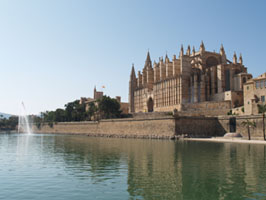 |
Spain | Travel | Regions | Cities | Coasts | Islands | Culture |
| Spain / Balearic Islands / Mallorca / Palma de Mallorca |
|
| More Information | ||
| Plan your Trip | ||
| ||||||
 La Ciutat, as the Mallorquines call their capital, will impress you from the moment you arrive to its port: yachts, palms, the cathedral ... Palma creates magic, more than ever in the early hours of the day. History and modernity melt together with the deep blue of Mediterranean sea. Approximately 320.000 people live here, about half of the island's total population.
La Ciutat, as the Mallorquines call their capital, will impress you from the moment you arrive to its port: yachts, palms, the cathedral ... Palma creates magic, more than ever in the early hours of the day. History and modernity melt together with the deep blue of Mediterranean sea. Approximately 320.000 people live here, about half of the island's total population.The city's cultural offer is impressive, specially if you take its size into consideration, and there is a large number of monuments you really should not miss. The Cathedral This is, probably, the most distinctive landmark of Palma. The cathedral, called la Seo by the Mallorquines, was constructed from 14th to 19th century, and the highly creative Antoni Gaudí designed its interior in 20th. century. Results are fascinating and original at the same time, almost impossible to describe with words. Most outstanding are perhaps the Puerta del Mirador, a door towards the sea created by architect Guillen Sagrera, and, in the interior, the chapels Capilla Real and Capilla de la Trinidad, as well as the museum with masterworks specially of the Baroque epoch. La Almudaina The "Royal Palace", constructed over the remains of the Muslim Alcazar, was the residence of the early kings. La Lonja Perhaps one of the most outstanding examples of Gothic civil architecture in all the Mediterranean area, with a great facade and fantastic interior. It was built by Guillem Sagrera and is used today as Museum of Arts. Consulado del Mar Close to "La Lonja", with an outstanding Renaissance gallery of 17th century. Today this building is the seat of the autonomous government. Paseo del Borne The heart of the historical center, and one of the most lively streets in town. At both sides it is flanked by narrow medieval lanes as well as elegant palaces of 19th century. The italian influence, very characteristical for Mallorca in general, is remarkably evident here. Between Cathedral and Plaza de Cort Here you will find several great palaces, as the ones of Colom, Villalonga, Oleo, Truyols, Oleza, the Archiepiscopal Palais, the church Iglesia de San Francisco and the Arabian Baths, one of very few remains of the Moorish epoch at Mallorca. Plaza de Cort Here are located the Ayuntamiento, town hall, with its outstanding 17th century facade, and the Gothic church Iglesia de Santa Catalina. El Puig de San Pere Located behind "La Lonja", this is another old quarter of town that is well worth a visit. Of particular interest are the church Iglesia de Santa Cruz, of 14th century with a 13th century crypt, the Palacio de Montenegro, Casa Weyler and Casa Belloto. Around Plaza Mayor La Rambla and Avenida de Jaime III are two important shopping streets with beautiful buildings, as Casa Berga (today the province's court of law) with its impressive Baroque balcony. Calle del Sindicato was the seat of the medieval committees. Castillo de Bellver A fortress located on top of a hill close to the historical center, built by Peré Salvá during the Gothic epoch. Its elegant appearance almost makes forget that it was originally constructed to defend Mallorca's inhabitants from their enemies. In its interior there is a museum with a valuable collection of pieces of classical antiquity. More information: Balearic Islands | Mallorca | What to see | Nightlife | Photo Tour |